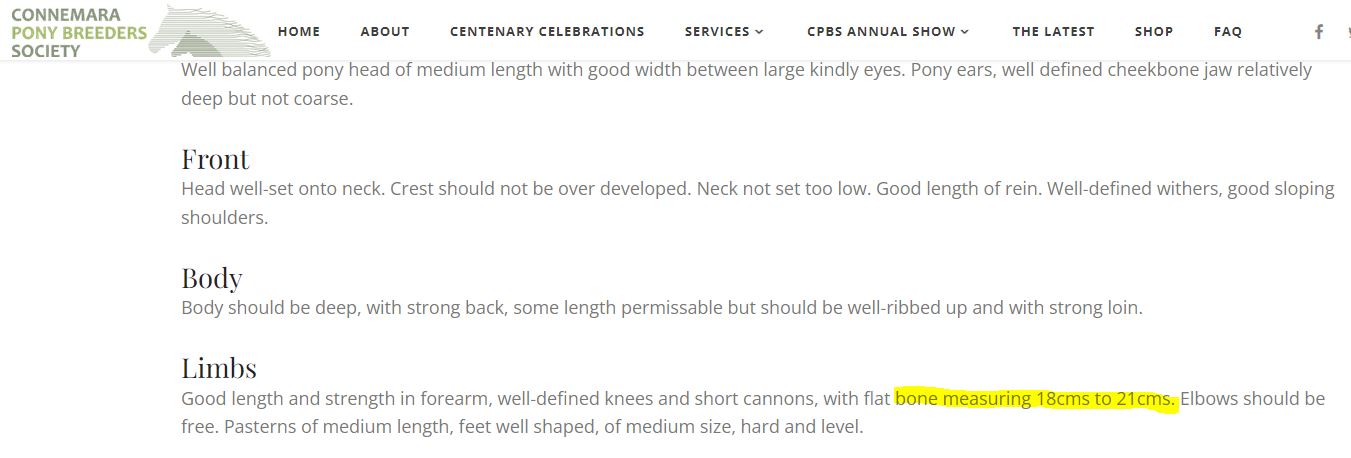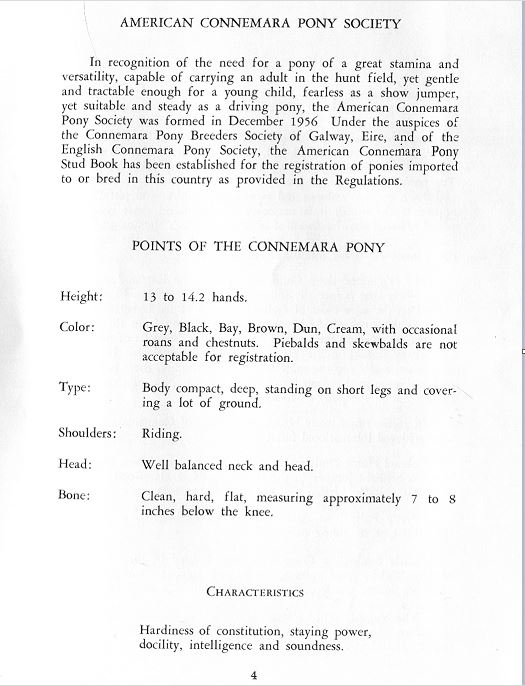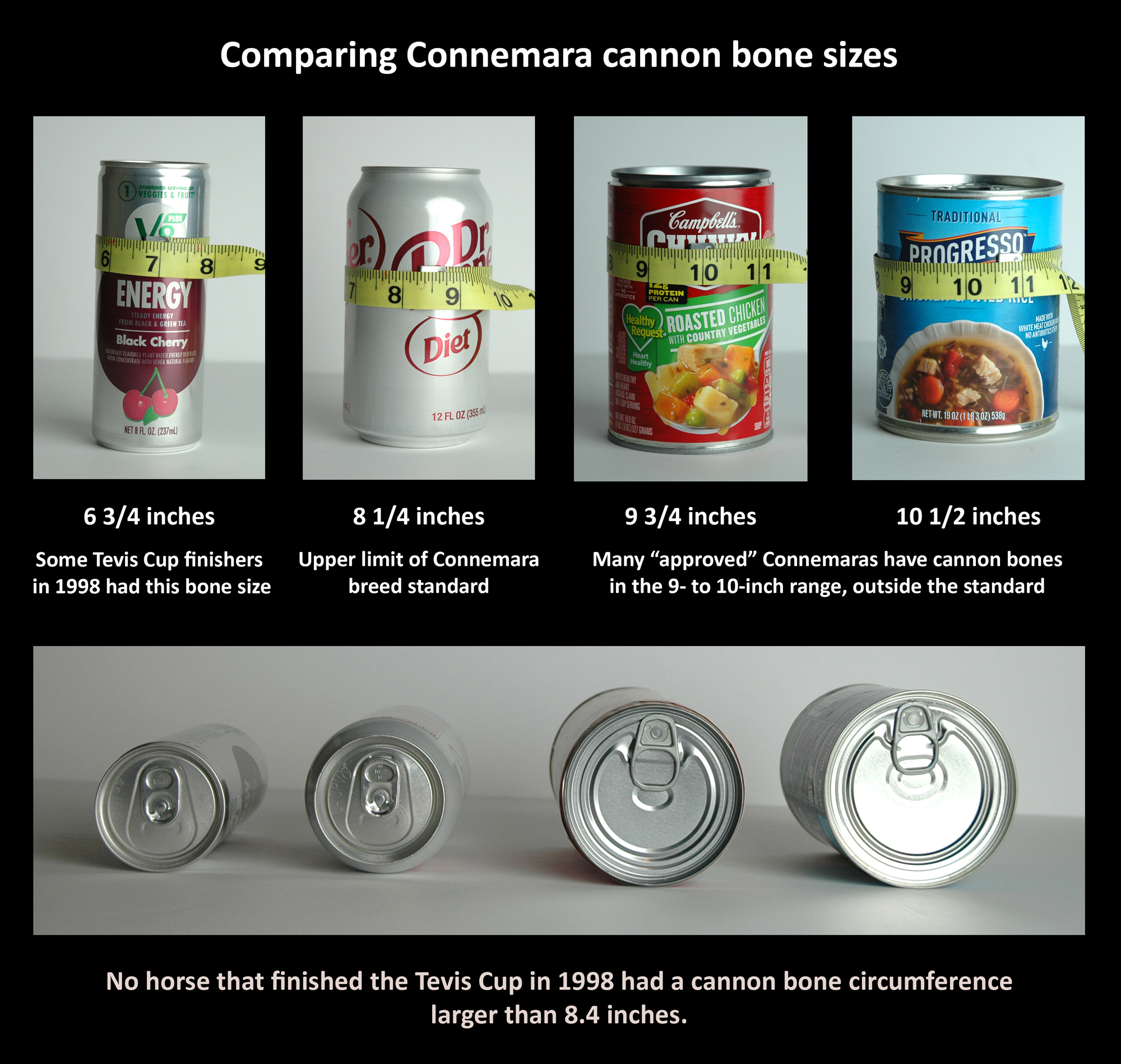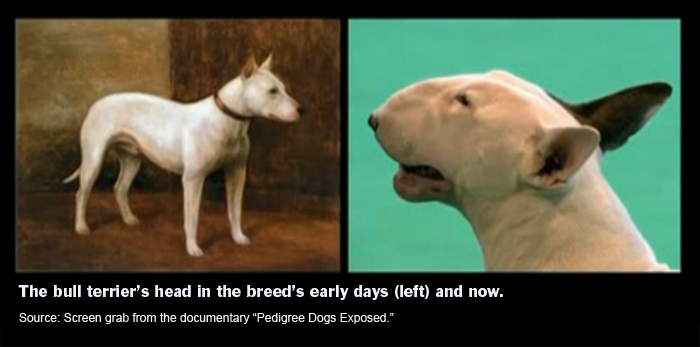ACPS inspectors alter Connemara breed standard for cannon bone, benefiting their own stallions
I am deeply disappointed that you have not followed your own directive to affiliates to do the right thing — a directive laid out during your live-streamed town hall in June 2013.
You have allowed inspectors in the American Connemara Pony Society (ACPS) to alter the Connemara breed standard when they use it in inspections, employing a word trick, so they can approve or give premium status to stallions, including their own, that otherwise would fail an inspection based on the real breed standard.
Using this trick, the inspection process is distorting the Connemara away from the breed standard that was put in place by Ireland 100 years ago and defined in print by the ACPS in 1959.
The question is: Now that you know the inspection criteria does not match the breed standard, will you do the right thing and demand that all premium and approved Connemaras judged against the altered standard be failed and the inspection process stopped?
Or will you do what you said you wouldn’t do: Look the other way because you don’t want to offend an affiliate that might walk away from US Equestrian?
Promoting trick on US Equestrian website
You accepted the ACPS as an affiliate, one fostering a unique breed, based on its breed standard.
But, now, you are endorsing the inspection trickery and the distortion of the Connemara by promoting Connemara inspections prominently on your website.
You wouldn’t let me form a competing society for a Connemara in the United States to promote the type of Connemara the ACPS originally defined, saying you would accept only one breed affiliate, but you will allow this group to subvert its mission of being the American caretaker of the Connemara.
US Equestrian asks affiliates in 2013 to be ethical
Your town hall livestreamed on June 3, 2013, emphasized that your organization would prioritize the welfare of the horse going forward. You asked all your affiliates to examine their practices and clean up their act.
You wanted them to do the right thing.
Olympic gold medalist David O’Connor said affiliates should act as if a TV news crew was following them around and broadcasting their every move to the world.
Was that a fleeting gimmick in the face of damaging media reports of drugged children’s ponies and soring tactics used on Tennessee Walkers?1
You said you would no longer look the other way when affiliates allowed or promoted unethical practices.
And, yet, not only have you ignored the major anti-trust issues with inspections in the ACPS (breeders inspecting competing breeders’ horses), despite my repeated attempts to get your attention, you are now flaunting those inspections.
It shows me that you seem to care more about hanging on to your affiliates than doing the right thing at all.
Cannon bones exceed Connemara breed standard by 2 inches
The inspections are giving premium or approved status to Connemaras whose cannon bones are as much as 2 inches outside the upper limit of the breed standard, even though the stallions are close to pony size. The upper limit is about 8 inches, or 8.26 inches when Connemara societies use a decimal. The lower limit is 7.08 inches. It translates to 18 to 21 centimeters in Europe.
Some premium or approved stallions have 10-inch cannon bones and advertise it.
Do you know the cannon bone size of a giant Shire? The Australian Shire, which averages 17.2 hands in height, is considered to have ample bone if the cannon bone is 11 inches, according to its breed society.
So, now the ACPS is encouraging exaggerated cannon bones in ponies almost the size of the cannon bone of a 17-2 hand Shire.

The Australian Shire averages 17.2 hands; 11 inches is considered ample for cannon bone size for this giant horse. (Source: Shire Horse Breeders Australia Inc.)
Look up the breed standard yourself
The breed standard for cannon bone size, set by Ireland’s Connemara Pony Breeders Society (CPBS), can be found on the CPBS website, in addition to the websites of Connemara breed societies all over the world, but not the ACPS, because the ACPS removed that sentence. See below.
The ACPS is going to retort that its inspections criteria follow the rules of the International Committee of Connemara Societies, a group that has fallen into disarray. It’s hard to tell if it exists at all. You won’t find a website. It has a page on the CPBS website from perhaps 2015 that lists US officials who have passed away.
Nonetheless, the ACPS says on its own website that its inspections “assure owners that their ponies conform to a worldwide standard.” Yet, the worldwide standard is a cannon bone no more than 8.26 inches, or 21 centimeters.
Below are the breed standards shown publicly on breed society websites, including Ireland’s, as of December 2023.

Connemara Pony Breeders Society breed standard for cannon bone size.
British Connemara Pony Society:

British Connemara Pony Society breed standard for cannon bone size.
Australian Pony Stud Book Society:

Australian Connemara breed standard for cannon bone size.
How the ACPS seemed to implement the trick
The ACPS has removed from its website the cannon bone standard that once said “about 7 to 8 inches,” though those measurements remain the breed standard.
Removing it hides the fact that ACPS inspectors fudged the inspection criteria for cannon bone size to “OVER 8.26 inches” for inspections.
The inspectors’ stallions were too thick boned and wouldn’t have passed an inspection if compared with the breed standard.
Thus, the wording for the breed standard on the ACPS website conflicted with the wording for the altered inspection criteria for many years.
I pointed it out on my website. And someone deleted the 7 to 8 inch cannon bone wording from the breed standard on the ACPS website.
But they didn’t erase the archived pages on the Wayback Machine. The discrepancy was easily found, so I put together this screengrab comparison for the years 2008 to 2013.

ACPS inspection criteria versus breed standard for cannon bone. Note the “over” added to the inspection criteria for cannon bone.
Stallions that should fail are awarded ‘approved’ or ‘premium’ status
I don’t agree with breeds having breed standards or inspections in a world where we’ve tried to put eugenics movements behind us.
But if an inspection exists, it should judge a Connemara against the Connemara breed standard.
Inspections are the main activity in the ACPS. The society cares only about creating two classes of ponies, approved and unwanted. People use inspections as a top promotional tool.
An inspection is to determine if the Connemara meets the breed standard. It’s a test.
If I take a test and miss the answers, I fail. So do you. We get an F.
And, yet, Connemaras that don’t meet the breed standard because their legs are too thick not only are passing inspection, they are being given premium labels and promoted as the optimum Connemara. It’s an A++ that they wave in everyone’s faces.
Why? Because the inspectors are breeders. They are judging the competition and promoting their own stallions. And they have successfully sold the marketing message that thick is best.
But 9- or 10-inch cannon bones are not the breed standard.
If you check your own affiliate files, you will see that when the ACPS was founded in 1956 and defined its breed standards at its first meeting in 1957, it set the breed standard for a Connemara to be a pony with a cannon bone of 7 to 8 inches, following Ireland and England. A photo of that breed standard in Stud Book I, published in 1959, appears below.

Connemara breed standard defined in ACPS Stud Book 1, published in 1959.
You have on your website a video of Connemara inspections explained by prolific inspector Sarah McCrae Thrasher, whose own “approved” stallion has a 10-inch cannon bone. Thrasher prominently advertises the approved status and the oversized bone.
You can find the ad here, as archived on the Wayback Machine.
The 10-inch cannon bone should fail the Connemara inspection. It’s simple math. Ten is not eight. Ten is much bigger than eight, especially when it comes to circumference.
But the 10-inch cannon bone doesn’t fail if you control and shape the inspection program, including pulling the wool over US Equestrian’s eyes on what is actually happening in these inspections.
I found ads for many premium stallions online. Those that list the cannon bone size all have cannon bones of 9 to 10 inches. I can add links to those, too, if you’re not convinced.
Not only are you doing exactly what you said you wouldn’t do in 2013 — ignoring wrongdoing — you are giving it your seal of approval.
Visualizing the difference
The comparison below was added Jan. 30, 2024. It’s important to see the difference between the upper limit of the Connemara breed standard — the soda can measuring 8 1/4 inches — and the cannon bone size of Connemaras with much larger circumference that are passing inspection — the much larger soup cans.
Note that a study of the cannon bone size of Tevis Cup competitors in 1998 showed that no finisher of the 100-mile ride had a cannon bone size larger than 8.4 inches. A large cannon bone is very heavy. A horse has to be able to move its legs. Why weigh down a pony-size Connemara with 9- or 10-inch cannon bones that violate the breed standard anyway?

Comparison of cannon bone circumference using common objects.
Breeders with conflicts of interest are inspectors
Having breeders inspect competitors’ stallions should have been enough of an anti-trust issue for you to shut down ACPS Connemara inspections two decades ago.
Also, you should know that a top inspector told me in 2005 that my parents’ beautiful stallion was not the right type (she said he was too refined) to be a real Connemara, and she had just failed a black sleek stallion that was nice by any standard and that looked just like him, but he wasn’t the right type either. She noted that the stallion had just missed the cannon bone measurement on the low end. She thought the stallion was a grandson of our stallion. Basically, she was bragging that she had created an inspection system that would fail any stallion that looked like ours (because our stallion beat her stallions many times in Connemara conformation classes).
Our 14-2 hand stallion had a cannon bone of 8 inches. I measured twice over the years. He was at the upper limit of the breed standard.
The inspectors — amateurs and breeders with conflicts of interest whom you are now allowing to be “experts” on your website — objected to a stallion who perfectly matched the breed standard. What does that say about the inspectors if they want to fail a pony that matches the breed standard?
US Equestrian fails to protect a stallion
And, as that one inspector bragged to me, she had failed a stallion who just missed the lower limit on cannon bone size. So it’s OK for a Connemara to have a cannon bone 2 inches bigger than the breed standard but not for one to miss the lower end by, say, 1/16th of an inch.
You have enabled a bunch of fiercely competitive business owners — and at least one seemingly sore loser — to use this inspection process to promote their own coarse stallions.
And you completely failed the stallion that was rejected at that inspection. You did not look after his welfare. You did not do the right thing.
These inspectors say they are saving the Connemara. No. They are making it distorted and grotesque, just as breeders of the bull terrier morphed that dog years ago, as demonstrated in the British documentary “Pedigree Dogs Exposed.” Maybe some people think this is a good thing. It makes me ill.

ACPS inspectors are changing the breed to benefit themselves. And you are promoting it.
What will US Equestrian do now?
So, will US Equestrian live up to its directive and act ethically now?
I am not the bad guy. I am merely forcing you to see what’s going on.
You cannot unsee the ACPS’ altered breed standard.
You cannot unsee the current Connemara breed standard published all over the world.
How will you respond?
1. Dec. 27: 2012: New York Times: Sudden Death of Show Pony Clouds Image of Elite Pursuit
April 2013: Horse Illustrated: New bill aims to end soring of Tennessee Walking Horses